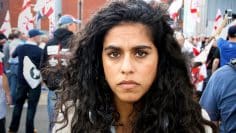LA 92
LA 92 chronicles the events leading up to and during the 1992 Los Angeles riots. It presents a raw and unflinching look at one of the most significant civil disturbances in American history, using only archival footage to tell its story.
The film begins by setting the stage with footage from the 1965 Watts riots, highlighting the long-standing tensions between the Los Angeles Police Department and the city’s African American community. This historical context serves as a haunting reminder that the issues that sparked the 1992 unrest were deeply rooted and had been simmering for decades.
The narrative then shifts to the infamous beating of Rodney King by LAPD officers in March 1991. The amateur video of this brutal incident, captured by George Holliday, shocked the nation and became a catalyst for widespread outrage. It follows the subsequent trial of the officers involved, building tension as it approaches the verdict that would ultimately ignite the city.
When the jury acquits the officers on April 29, 1992, the documentary captures the immediate and visceral reaction of the community. The footage shows the rapid escalation of events, from initial protests to full-scale riots, looting, and arson. The chaos and violence that engulfed Los Angeles are presented in stark, often disturbing detail, offering viewers an unfiltered view of a city in crisis.
Throughout LA 92, the filmmakers weave together various perspectives, including those of law enforcement, political leaders, community members, and the media. This multifaceted approach provides a detailed view of the complex social, racial, and economic factors that contributed to the unrest. It also sheds light on the often-overlooked tensions between the African American and Korean American communities, which came to a head during the riots.
One of the most striking aspects is its ability to convey the raw emotions of those involved. From the anguish and anger of protesters to the fear and confusion of bystanders caught in the chaos, it captures the human toll of the riots with unflinching honesty. The inclusion of Rodney King’s famous plea for peace – “Can we all get along?” – serves as a poignant moment amidst the turmoil.
As the riots progress, the film documents the city’s descent into near-anarchy, with widespread looting, burning buildings, and violent confrontations between rioters and law enforcement. The deployment of the National Guard and the implementation of a city-wide curfew underscore the severity of the situation and the authorities’ struggle to regain control.
The documentary concludes by reflecting on the aftermath of the riots, including the physical destruction, loss of life, and the deep scars left on the city’s psyche. It raises important questions about race relations, police accountability, and social justice that remain relevant today.










